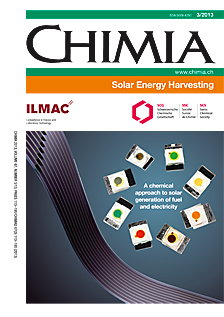Computational Comparison of CPDT to other Conjugated Linkers in Triarylamine-based Organic Dyes
DOI:
https://doi.org/10.2533/chimia.2013.116Keywords:
Charge transfer, Computational chemistry, Excited states, Grätzel cell, Organic dyesAbstract
The use of the cyclopentadithiophene (cpdt) fragment to chemically link electron donor and acceptor groups has become a rather common procedure to design new organic dyes with enhanced light harvesting properties. The photo-to-current efficiencies obtained by sensitized solar cells with dyes incorporating the cpdt moiety are commonly improved with respect to other similar ?-fragments as separators. In many cases, the advantages of cpdt can be related to the larger extinction coefficients obtained. In this work we perform a detailed computational study of triarylamine-based organic dyes with the cyanoacrylic acid as the acceptor group and considering a variety of conjugated linkers with cpdt as the reference case. The influence of slightly different linkers and donor groups in the computed excitation energies and oscillator strengths is discussed by means of molecular geometries and frontier orbitals. The structural characteristics imposed by cpdt compared to similar conjugated bridges are responsible for its larger computed oscillator strengths. The insertion of an ethylene unit between the donor group and the linker systematically reduces the energy gap to the first excited singlet state and yields larger oscillator strengths of the optical transition. These results could be very helpful in the quest of new organic dyes with improved properties as sensitizers in Grätzel cells.Downloads
Published
2013-03-27
Issue
Section
Scientific Articles
License
Copyright (c) 2013 Swiss Chemical Society

This work is licensed under a Creative Commons Attribution-NonCommercial 4.0 International License.
How to Cite
[1]
C. Climent, D. Casanova, Chimia 2013, 67, 116, DOI: 10.2533/chimia.2013.116.







